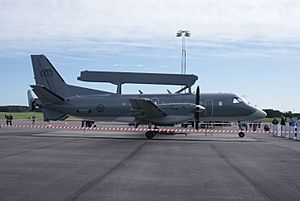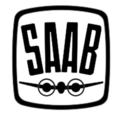Saab AB facts for kids
 |
|
|
Formerly
|
|
|---|---|
| Publicly traded Aktiebolag | |
| Traded as | OMX: SAAB B OMX Stockholm 30 |
| Industry | Aerospace and defence |
| Founded | 1937 in Trollhättan, Sweden |
| Founders |
|
| Headquarters | Stockholm, Sweden |
|
Area served
|
Worldwide |
|
Key people
|
|
| Products |
|
| Revenue | |
|
Operating income
|
|
| Total assets | |
| Total equity | |
| Owner | Wallenberg family (38.9%; 47.7% votes) |
|
Number of employees
|
|
| Subsidiaries |
|
Saab AB is a Swedish company that makes things for aerospace and defense. It was originally called "The Swedish Aeroplane Corporation," or SAAB for short.
The company is based in Stockholm, Sweden. However, much of its design and manufacturing work happens in Linköping.
Saab was first started in 1937 to build airplanes. It quickly joined with another aircraft maker called ASJA in 1940. This created the SAAB group.
Later, in 1947, Saab also began making cars. This car part of the company became Saab Automobile in 1990. It was a joint company with General Motors.
From 1968 to 1995, Saab was part of a larger company called Saab-Scania. This group also included the truck maker Scania. Even after they split up, both Saab and Scania still use the cool griffin logo. This logo comes from the coat of arms of the Swedish region of Scania.
Contents
History of Saab
Early Days of SAAB
Saab was founded in 1937. Its first name was Svenska Aeroplan Aktiebolaget, which means "The Swedish Aeroplane Corporation." It started in Trollhättan, Sweden. The company was created from an aircraft engine division of another company called NOHAB.
At that time, the Swedish Air Force wanted to make sure Sweden could build its own aircraft. Saab was set up to help with this goal. There was another aircraft company called ASJA in Linköping. ASJA was already a leading aircraft maker in Sweden.
In 1937, Saab and ASJA tried to work together under a parent company called AB Förenade Flygverkstäder (AFF). However, they still competed for contracts. Saab in Trollhättan built some planes, like the Junkers Ju 86 bomber under license. But ASJA won most of the contracts.
In 1939, it was decided to combine the companies more formally. ASJA became the main part of the SAAB group. The factory in Trollhättan became SAAB/T, and the Linköping factory (ASJA) became the main design center.
Building Swedish Aircraft
During World War II, Sweden needed to build its own military aircraft. This was because it was hard to get planes from other countries. Saab became very important in making sure Sweden had its own aircraft. This policy of building planes at home continues today.
Saab's first aircraft was the SAAB 17 light bomber, which first flew in 1940. Then came the SAAB 18 bomber in 1942 and the SAAB 21 fighter in 1943. The SAAB 21 was special because it was one of the first planes to use a modern ejection seat.
After the war, Saab looked for new things to make. There was a big shortage of cars in Europe. So, in the late 1940s, Saab started making cars in Trollhättan. The first car was the Saab 92. Production began in December 1949. Around 1950, the company started using "Saab" instead of "SAAB."
In the late 1950s, Saab also got into making computers with a division called Datasaab. They wanted to make a computer small enough for airplanes. Datasaab developed computers for banks and other uses. The aircraft computer (CK 37) was used in the Viggen jet in 1971.
Saab AB Today
In 1965, the company changed its name to Saab AB. This showed that it was involved in many different activities.
In 1968, Saab AB merged with Scania-Vabis, a company that made trucks and buses. They became Saab-Scania AB.
In 1990, General Motors bought 51% of the car division, Saab Automobile. They bought the rest ten years later.
In 1995, Saab-Scania split into two separate companies: Scania AB and Saab AB. This happened because the car division was no longer fully owned by Saab.
Also in 1995, Saab Military Aircraft teamed up with British Aerospace (now BAE Systems). They formed a company to make and sell the Gripen fighter jet around the world. BAE Systems was a major shareholder in Saab for a while, but they sold their shares by 2011.
Saab has continued to grow by buying other companies. In 2000, they bought Celsius AB. In 2023, Saab acquired Blue Bear Research Systems, which makes AI-powered drone systems. They also bought CrowdAI, an artificial intelligence company.
Aircraft Production
Saab mainly focuses on building fighter aircraft. Saab has been making planes since the 1930s. Before the JAS 39 Gripen, Saab made famous jets like the Tunnan, Lansen, Draken, and Viggen.
Saab also made civilian planes like the Saab 340 and Saab 2000. These were mid-sized propeller planes for passengers. Most of Saab's aircraft development and manufacturing happens in Linköping.
In 2019, Saab announced plans to build a new factory in the U.S. This factory will help assemble the T-7 Red Hawk jet trainer. This plane was developed by Boeing and Saab for the United States Air Force.
How Saab is Organized
Saab is divided into different business areas. Each area focuses on specific products and services.
Aeronautics
The Aeronautics area works on airborne systems, like parts for planes and drones. They build parts for the JAS 39 Gripen fighter jet. They also make sections for large planes like Airbus and Boeing aircraft.
Aeronautics is also involved in developing the JAS 39 Gripen and the Skeldar VTOL UAV (a drone that can take off and land vertically). They also help market and support the Gripen fighter jet.
Dynamics

Dynamics makes ground combat weapons, missile systems, and torpedoes. They also create sensor systems and unmanned underwater vehicles. These products are for armed forces and for civil security.
Some of their short-range weapons include the Carl Gustaf and AT4. They also make missile systems like the RBS 70 and RBS 15.
Surveillance
The Surveillance area provides systems for watching and monitoring. This includes airborne surveillance, like the GlobalEye and Saab 2000 Erieye AEW&C aircraft. These planes can detect things from high in the sky.
They also make ground-based and naval radars, such as the Giraffe radar range. This area also develops electronic warfare systems and combat systems.
Industrial Products and Services
This area was created in 2015. It includes business units like Combitech, Avionics Systems, and Traffic Management. These units focus on selling products and services to other businesses.
Unlike other parts of Saab, these units don't mainly sell to governments. This allows them to have different strategies for growth.
Support and Services
This area provides maintenance and support for Saab's products. They offer services like repairs, logistics, and regional aircraft maintenance.
Saab Aircraft Leasing is part of this area. It leases and resells Saab aircraft to airlines.
Saab Barracuda LLC
Saab Barracuda LLC is located in Lillington, North Carolina, in the U.S. This facility makes products that help hide military equipment. These are called signature management products.
One important product is the Ultra Lightweight Camouflage Net System (ULCANS). This net helps hide things from sight, heat sensors, and radar. It is used by the U.S. Army and other defense groups.
Saab Kockums
The Kockums shipyard is where Saab's submarine division is based. They build and maintain submarines.
Products Made by Saab
Military Aircraft
- Saab 17 (bomber/dive-bomber: built 1941–1944)
- Saab 18 (twin-engine bomber and reconnaissance aircraft: built 1944–1948)
- Saab 21 (fighter/attack aircraft: built 1945–1949)
- Saab 21R (jet-powered version of Saab 21: built 1950–1952)
- Saab 29 Tunnan (first jet fighter: built 1950–1956)
- Saab 32 Lansen (attack aircraft: built 1953–1959)
- Saab 35 Draken (fighter: built 1955–1974)
- Saab 37 Viggen (fighter/attack/reconnaissance aircraft: built 1970–1990)
- Saab JAS 39 Gripen (multirole fighter: introduced 1996)
- Saab 105 (twin engine trainer: built 1963–1972)
- Saab 340 AEW&C (airborne early warning and control aircraft: built 1994–1999)
- Boeing-Saab T-7 Red Hawk (advanced pilot training aircraft: developed with Boeing)
Cancelled Military Aircraft Projects
- Saab 36 (bomber, 1950s, not built)
- Saab 38 (attack/trainer, 1970s, not built)
Civilian Aircraft
- Saab 90 Scandia (passenger aircraft: built 1946–1954)
- Saab 91 Safir (single engine trainer: built 1946–1966)
- MFI-15 Safari/MFI-17 Supporter (single engine trainer: built 1971 – late 1970s)
- Saab 340 (passenger aircraft: built 1983–1999)
- Saab 2000 (high-speed turboprop airliner: built 1992–1999)
Experimental Aircraft
- Saab 210 (experimental aircraft: built 1952)
- Saab/Linköping University Generic Future Fighter.
Unmanned Aerial Vehicles (UAVs)
- Saab Skeldar
- Swiss UAV
Missiles
- RBS 56B BILL 2
- KEPD 350
- NLAW (shoulder-launched anti-tank)
- RB 04 (anti-ship missile)
- Rb 05 (air-to-surface missile)
- RBS 23
- RBS-15 (anti-ship missile)
- RBS-70
- Meteor BVRAAM
- Ground Launched Small Diameter Bomb
- 9LV Naval Combat Management System
- TactiCall Integrated Communication System
- Sea Giraffe 180 (SG180) medium air/surface RADAR
Surface Radar Systems
- Giraffe 1X
- Giraffe 4A
- ARTHUR (counter-battery radar)
Boats
- Saalina
Images for kids
-
A SAAB 18B being built at the Saab Linköping factory during World War II.
See also
 In Spanish: Saab para niños
In Spanish: Saab para niños
- Datasaab
- List of Swedish aircraft
- Saab Automobile
- Saab Training and Simulation








